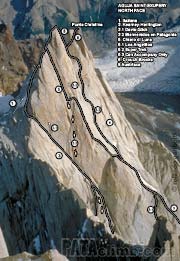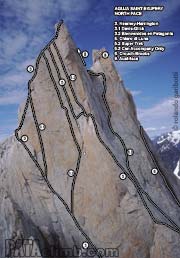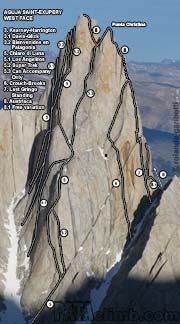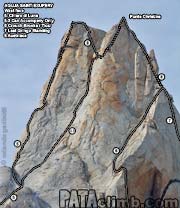Aguja Saint-Exupery - West face
5. Chiaro di Luna
5.1 Los Angelitos
5.2 Supertrek
5.3 Can Accompany Only
750m 6b+
Maurizio Giordani, Rosanna Manfrini and Sergio Valentini (IT), 4-5/11/1987.
Description. For the grade it is one of the best free routes in the area. It starts 30 meters up the basalt dike. Twenty pitches aprox.
History. The first ascentionists descended in the moonlight, hence the name.
Solo ascents. Alexander Huber (DE) in 2011, with one bivy. In early 2015 Brette Harrington (US) did the first free-solo ascent taking a mere three hours. With this ascent she became the first woman to have soloed one of the towers in the massif. Less than ten days later Marc-André Leclerc (CA) did the second free-solo ascent.
On 3/2019, Jim Reynolds (US) free-soloed the route, carrying no rope or gear and down-free-soloing the Kearney-Harrington (550m 6a+). He onsighted both routes. Two days earlier he had free-soloed the complete (sit-start) Filo Oeste (1000m 6b) of Aguja Rafael Juárez, down-free-soloing the Anglo-Americana (350m 6b). A little over a week later he free-soloed the Afanassieff route on Cerro Fitz Roy (1500m, 6a+), taking 6:38hs to reach the summit and 8:30hs to down-free-solo the same route. In the early 1900s, Austrian Paul Preuss, considered by many “the father of style” had preached and practiced free-soloing up and down peaks as the “honest, sporting” way to climb (his words). He argued that one should “overcome difficulties with your own strength, on ascent and descent alike,” explaining that “if there is someplace you can’t go down, you should also not go up.” One could have never imagined that Preuss's maxims would be one day applied to a peaks like Agujas Rafael Juárez, Saint-Exúpery and Cerro Fitz Roy. One stylistic argument one can make about Jim's ascents is that they are the first free ascents of these formations. If rappels and pendulums are not considered free-climbing in a face such as El Cap, why should an ascent of a jagged peak be considered free unless the descent is also done free? More info about Jim's free-solo ascents and descents here.
Approach. Polacos.
Descent.You can descend the route for which you will need to bring a lot of cord and a hammer. The faster descent is down straight from the base of the upper chimney to reach the Kearney-Harrington ramp and down this directly into the couloir. This second option requires that you bring boots and crampons with you.
Bibliography. Mountain Magazine 125 p. 13; AAJ 1989 p. 176; CAI-Rivista Mensile 1988/4 p. 76; Rivista della Montagna 96 p. 13; Lo Scarpone 1988/5 p. 7; Lo Scarpone 1988/11 p.11; Samas/Alpinismo Oggi (1991) p. 14-15.
|



